AMD Kaveri Review: A8-7600 and A10-7850K Tested
by Ian Cutress & Rahul Garg on January 14, 2014 8:00 AM ESTDrawing Performance Conclusions
As I progressed through the testing for this review, I became aware of trends in two things: absolute performance, in terms of numbers, and generational improvements across platforms. With AMD moving the Bulldozer based architectures from Piledriver in Trinity and Richland to Steamroller in Kaveri, the base CPU design has had a relatively long run in order to be optimized to the limitations on the CPU side. Obviously AMD has also had a chance to change the lithography node in there as well, and as such has optimized for design rather than performance. This matters a great deal when we look at the power banding (45W, 65W, 95W) and performance in each segment.
In order to display just how much Kaveri has grown in relation to the previous generations, I processed our mountain of data to show graphs where percentage gain against the older generations really does matter. As mentioned previously in this review, it all depends on whether the software can take advantage of the new features afforded by the architecture. In this review we have spent a lot of time discussing advantages for Kaveri in terms of compute (HSA, hUMA, hQ) and gaming (Mantle, TrueAudio), but some of these are still a little way off for software integration. So what does that translate to if you are looking for an APU today – does Kaveri still expand its wings with the integration of the GCN architecture, or does it lag behind due to the lithography node no longer being optimized for frequency. The proof is in the results.
IGP Gaming, 1280x1024
For the 100W APUs at 1280x1024, there is almost no movement between the Richland and the Kaveri APUs, except for Company of Heroes which would seem to leverage the extra SPs more than the MHz available.
45W APUs are clearly in vogue at 1280x1024, each of them providing a good bump over Richland.
IGP Gaming, 1680x1050
1680x1050 sees more benefit for the 100W APUs, but the 45W APUs still show big leaps.
IGP Gaming, 1920x1080
At 1080p the effects are more pronounced all around.
CPU Timed Benchmarks
Unfortunately the CPU timed benchmarks at 100W are bit over the place. Here we are dealing with an IPC gain but MHz deficit, and each benchmark has a different way of dealing with it. For Agisoft, MHz wins, but for Xilisoft, the Kaveri improvements work out well for the system.
At 45W the situation is a lot more clearer, and the newer APUs have the advantage, especially in Adobe After Effects.
CPU Score Benchmarks
45W still makes the biggest jump when it comes to score based CPU benchmarks.
IGP Synthetics
I never like putting much thought into the synthetic results – here both the 100W and the 45W range are showing good improvements all around. 3DMark 06 has the most trouble getting improvements as it relies more on the grunt, rather than the features that Kaveri affords.
IGP Compute
Off the bat we can see just how much of a difference the Kaveri GPU Compute can make over previous APUs. This is still without hUMA fully being in effect while we wait for a proper driver and software stack to become available.
Up to a +222% boost from Kaveri is amazing for a 45W part.
AMD vs Intel
For a little tete-a-tete, putting the 65W Iris Pro up against the 65W Kaveri seems like a good idea. To add to the mix, due to the extreme price difference of Iris Pro in this equation, we also add the 95 W Kaveri for comparison.
It is interesting to note that at the lower resolutions the Iris Pro wins on most benchmarks, but when the resolution and complexity is turned up, especially in Sleeping Dogs, the Kaveri APUs are in the lead.


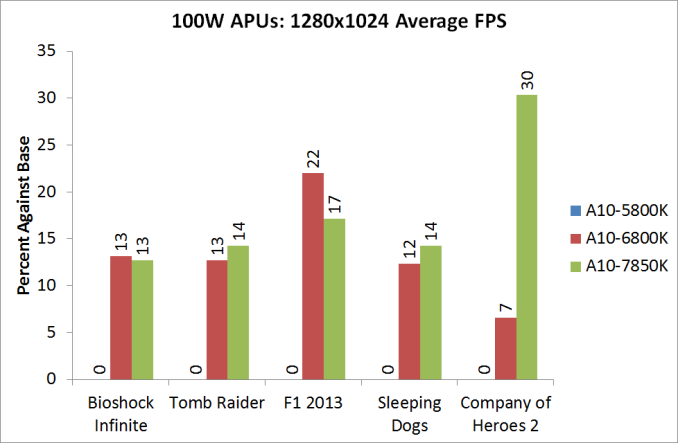
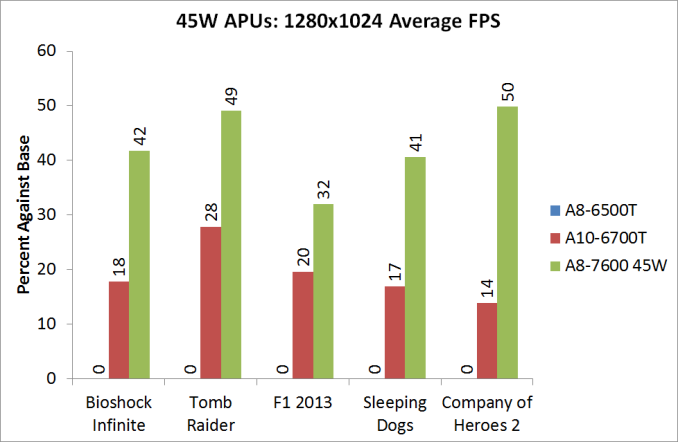
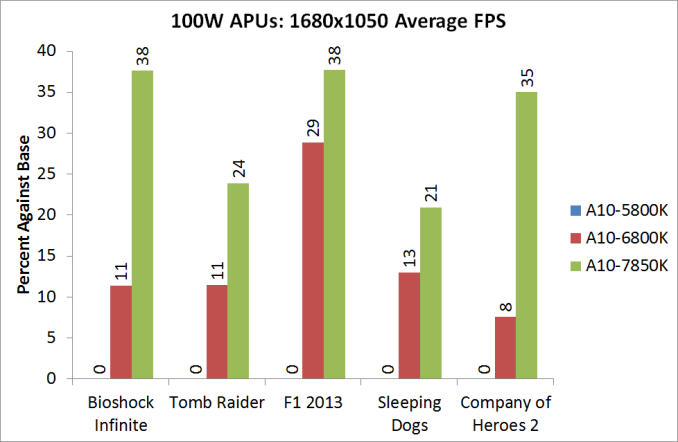
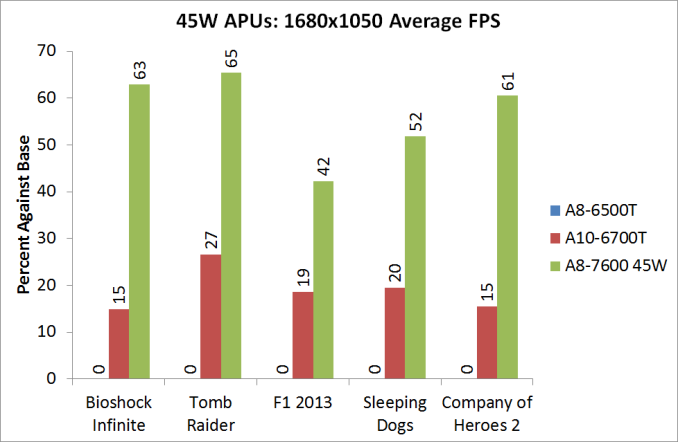
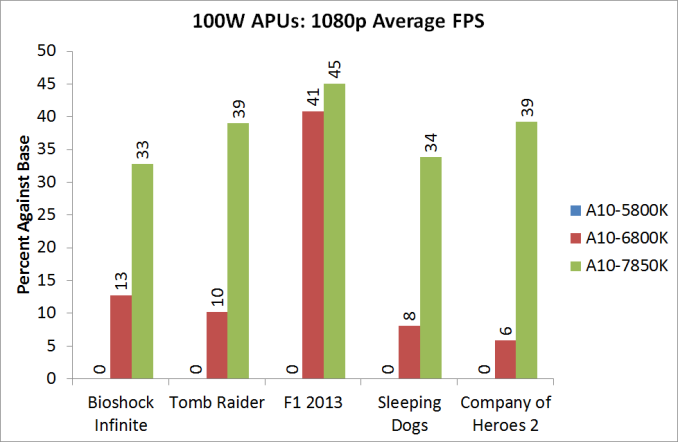

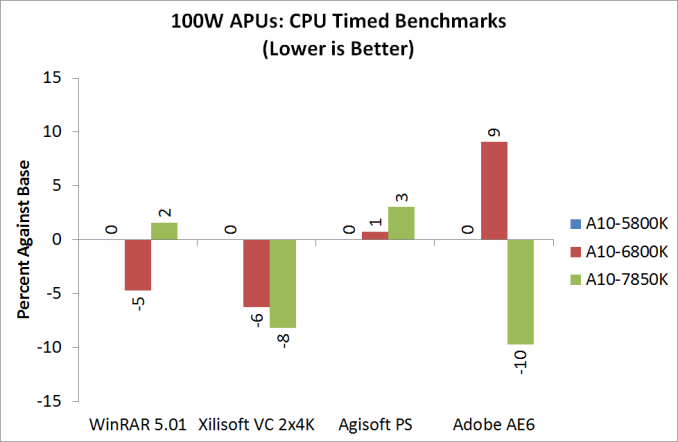
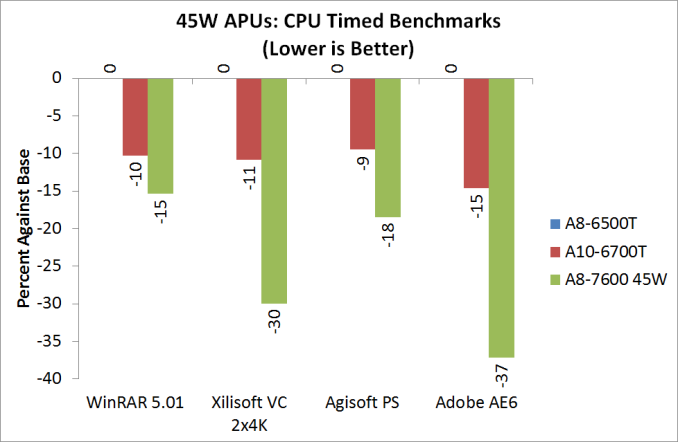

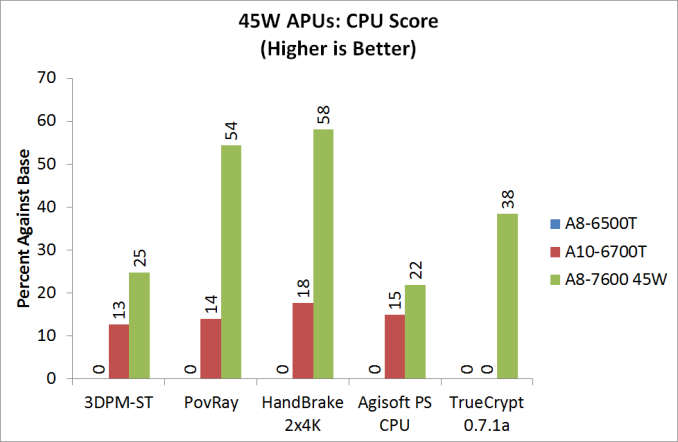
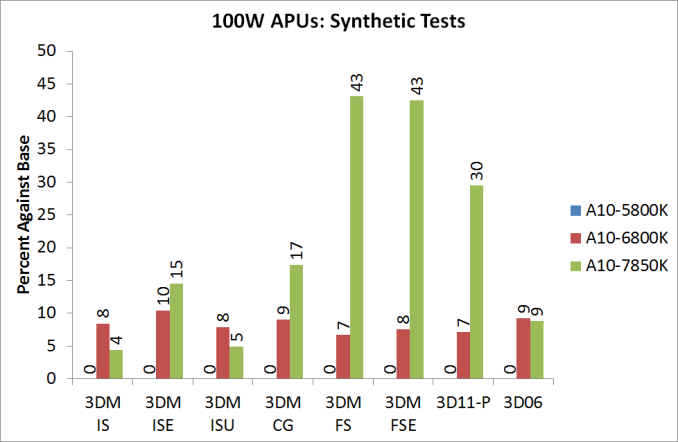
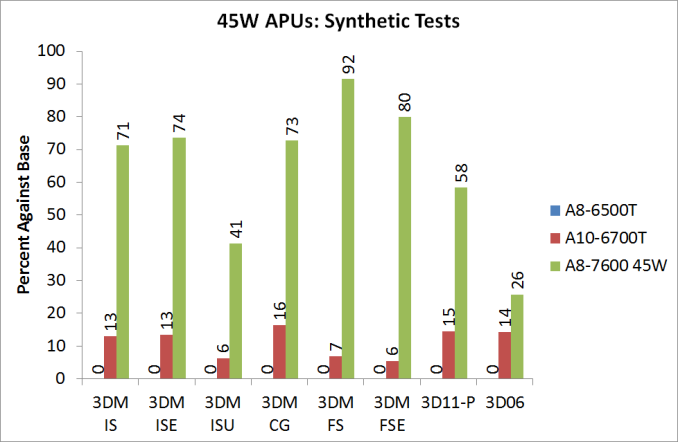
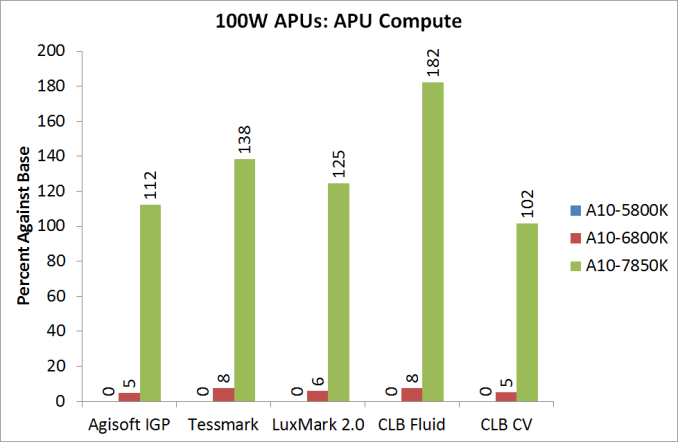

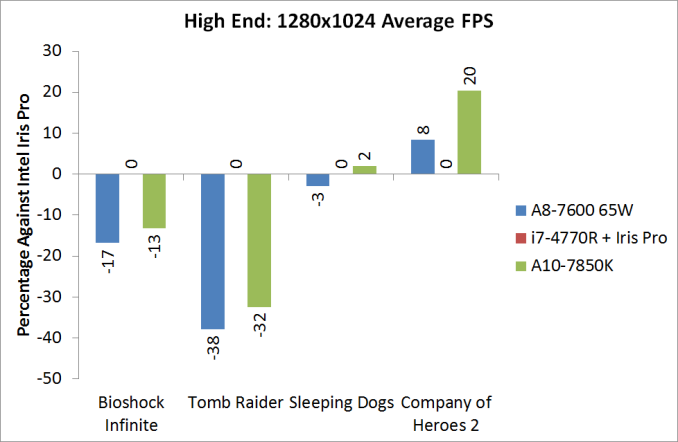
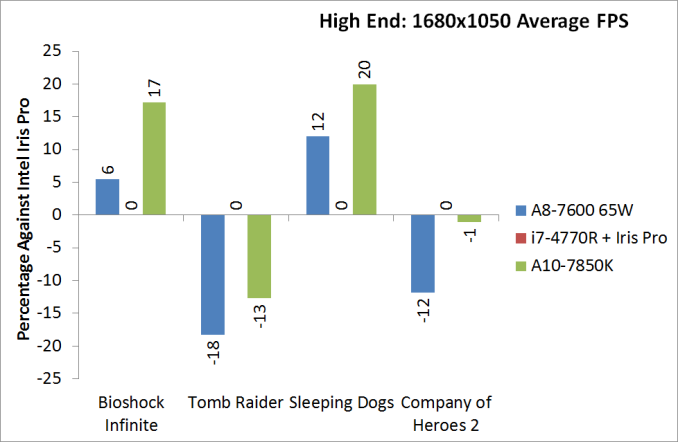
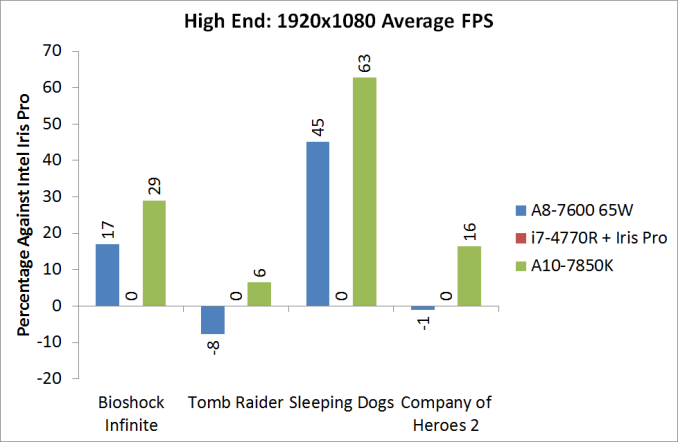








380 Comments
View All Comments
nader_21007 - Saturday, January 18, 2014 - link
Can you show me what improvement haswell did over previous gen? TDP going from 77W to 84W, meanwhile performance droped in most cases. Can't you see the charts in this review?Principle - Tuesday, January 14, 2014 - link
Andrew, that depends based on size, budget, etc...and I own an AMD Piledriver CPU and could never tell you when it was supposedly slower, maybe a game takes a couple seconds longer to load, but after that its all the same.And I have used Intel CPUs too, and have hiccups and lag multitasking with them in real life, that never happens on my AMD systems. If you get an i5 and an AMD GPU, that would be great and last with the GPU compute advantage of AMD GPUs and the Mantle potential.
These Kaveri have a lot of value at launch for the entertainment center PCs, or ITX platforms because at 65W or even 45W it delivers a lot of performance in one chip that you can keep cool and quiet in a small package. Also good for all in one PCs built into the monitor. Not for the avid gamer right now, but a little more future proof than an Intel CPU in my opinion.
ImSpartacus - Thursday, January 16, 2014 - link
If you're not gaming, is it really that hard to "future-proof" your CPU?I feel like most low end CPUs will perform "basic" non-gaming tasks for many years to come.
andrewaggb - Tuesday, January 14, 2014 - link
To be clear, I'd get an i5 quad core with a 260x or 270x. I realize they aren't at all in the same price range, but it's good performance per dollar.I was expecting Kavari to have 10% better cpu performance and 25% better gpu performance. This has equal cpu performance and essentially equal gpu performance. It has other improvements, but that's a serious dissappointment on the performance side of things.
I've already got 3 i5 quad cores with a 6870, 7850, and 270x in each and I'm happy with them. Just though Kaveri might be good enough, and it is for older stuff and minecraft and whatnot.
But it seems like yet another year that paying the extra money and having some longevity is going to be the right move.
Quite frankly my oldest system, the i5 750 with a 6870 would mop the floor with kaveri in everything but power consumption.
yankeeDDL - Wednesday, January 15, 2014 - link
You're kidding right?It practically doubled the performance per watt of Richland (45W Kaveri almost always outpaces 100W Richland) and that's disappointing?
It's true that Richland was way behind, but the improvement is massive.
There's still a glaring gap with Intel's CPU, but it is smaller.
Just as much as the glaring gap on the GPU side (but this time on AMD's favor) got wider.
HSA is the key for AMD to push the GPU advantage over to the CPU to compensate. If it works, then Kaveri will be really up to, or better of the core I5 which cost more than 2X ... "IF" ...
Jaybus - Thursday, January 16, 2014 - link
I'm not convinced HSA is the future. It is a diminishing returns issue. The only difference between HSA and SMP is different types of cores are being used. The bus arbitration and coherency issues are exactly the same. Neither is scalable to dozens of cores, let alone hundreds. HSA has the same limitations as SMP. Something like Knights Corner's ring bus and message passing is more likely the future. Near term, there is an advantage to HSA. Long term will rely on a much faster chip-to-chip interconnect to transfers and segmented memory to avoid the arbitration and coherency issues. CMOS silicon photonics maybe. That would enable optical busses orders of magnitude faster than PCIe, or in fact much faster than any chip-to-chip electronic bus, and that would make something like Knights Corner's ring bus the future path to high core counts.jimjamjamie - Thursday, January 16, 2014 - link
A genuinely interesting and insightful comment, thanks.artk2219 - Tuesday, January 14, 2014 - link
Until you play a game that uses more than 2 threads, or have tasks running in the background while gaming, then you'll wish you had those two extra threads. Seriously I wish people would quite trying to recommend dual cores for gaming or even general use, unless its in a machine for the type of person that only does one or two things thing at a time. Dual cores are showing their age now, its only going to be worse a year or two from now. Also why would you spend 90 on a Pentium dual core when you could spend 80 on an Athlon 750k or that same 90 on a 760k. They have similar single thread performance and stomp the g2120 in multithreaded situations, plus they're unlocked so you can overclock to your hearts content. Im not saying that Kaveri isn't overpriced right now, they could stand to drop 20 dollars for the top two chips and 10 for the last chip reviewed. But they just launched and those prices will change, and in the end its easier to point people to one part for all of their needs than it is to point them to two.http://www.newegg.com/Product/ProductList.aspx?Sub...
Nagorak - Wednesday, January 15, 2014 - link
The Intel processors are more energy efficient. That's one reason.artk2219 - Wednesday, January 15, 2014 - link
Fair enough, but its a negligible difference once you factor in the discrete GPU that you would be pairing it with anyways. Cooling it shouldn't be anymore of a problem than cooling the same setup with the DGPU, granted there aren't really any fm2+ itx boards so that may be a problem if you're going for a tiny size, but thats about it.